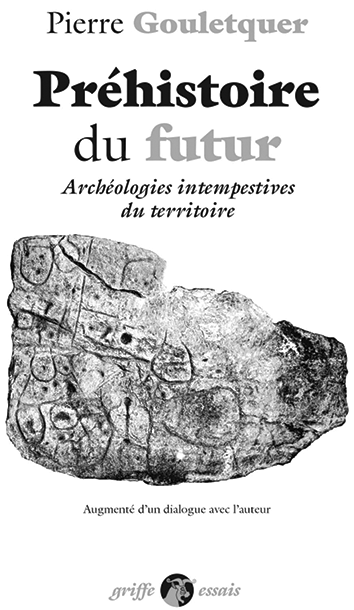
It has long been recognised that archaeological theory has been given much less attention in France than in other (mainly Anglo-American) countries (e.g. Scarre Reference Scarre1999). This small book represents an early exception. Préhistoire du futur (‘Prehistory of the future’) was first published in 1979 by the now defunct Éditions Bretagnes. The limited number of copies quickly sold out, and over the following decades the book gained fame within the community of French prehistorians and students for both its thought-provoking content and its elusive presence. Now, two young archaeologists, Sébastien Plutniak and Gwenolé Kerdivel, have convinced the author, Pierre Gouletquer, to re-publish the book to make it more widely available. The only new elements are a foreword by Plutniak and the transcript of an interview with the author at the end of the volume.
Pierre Gouletquer is now a retired archaeologist from western Brittany. Trained as a geologist, he worked as a CNRS researcher (Centre national de la recherche scientifique) from 1964 to 2004. His main research focused on the Mesolithic period of Brittany, using large-scale fieldwalking surveys over multiple years in the Département du Finistère. Involving both students and local enthusiasts, Gouletquer pioneered what is now called community archaeology. He can be regarded as a non-conventional prehistorian, whose work concentrated on producing archaeological information as much as questioning archaeological practices.
Préhistoire du futur presents the author's personal reflections on the discipline. Do not expect references to philosophers or theoretical archaeologists: the style is non-academic (with no references), deliberately provocative, and often humorous, supported by several comic-style drawings by the author. The book originated as a reaction against the institutional archaeology of the time and its focus on excavation and artefact studies, and against the claim that archaeology is a science (rather, for Gouletquer, archaeology is an art of storytelling). The first chapter tells how, after a PhD on Iron Age salt production based on related artefacts, the author started ethno-archaeological fieldwork on traditional salt production techniques in Africa. This experience enabled him to explore aspects typically ignored in conventional archaeological research: social activities and relationships beyond material culture. From this time, the author ‘ceased to be a prehistorian’ (p. 30) and started to draw from other fields, such as geography and sociology, in order to design his own approach to prehistory.
For Gouletquer, the solution starts with a change of scale: archaeologists should focus on ‘territories’ rather than isolated sites and artefacts, and should ideally live within the territory they study to gain an intimate knowledge of its character and people. The archaeology of territories is, in fact, the main topic of the book, whose subtitle in the new edition is Archéologies intempestive du territoire (Untimely archaeologies of territory). ‘Territory’ here is defined as ‘a protected surface belonging to a group, with remarkable places, limits and paths, integrated into the geographical surface by using its natural properties as well as possible’ (p. 143). This concern with prehistoric territories, and the use of Thiessen-polygon maps, which are numerous in the book, is quite characteristic of the 1970s New Archaeology, although the author claims his unawareness of the latter.
The term today is not commonly used in English-speaking scholarship (although see Zedeño Reference Zedeño, David and Thomas2016) but can be considered as an equivalent to ‘taskscapes’ (Ingold Reference Ingold1993). In the second chapter, the author discusses different models for the creation of territories and concludes that the ones most relevant to prehistory are customer behaviour territories and kinship territories. Chapter 3 describes the author's childhood territory in a small town in western Brittany. His perceptions of places around his home were shaped by different types of experiences, thus creating notions of space different from those of a top-down geography. The notion of boundary is discussed, using examples from both mobile groups in the Sahel and traditional Breton villages; and a brief allusion to the role of dolmens and menhirs as possible boundary markers in prehistory is made.
Chapter 4 looks at the organic creation of paths and roads within and between territories, again using modern examples, while Chapter 5 discusses the circulation and erosion of information within territories. Chapter 6 addresses spatial dynamics, using the example of the opening of a state primary school in the author's town in the early twentieth century, and how it attracted local pupils while competing with the older Catholic school. The final chapter returns to the concept of ‘kinship territories’—the dispersal of a family's generations—illustrated by different municipality maps from modern Brittany. These are compared with a distribution map of megalithic tombs in the same area, which, the author indicates, display similar distribution patterns.
The book presents many original thoughts and successfully helps to shift the reader's views from what has long obsessed prehistorians (isolated sites and artefacts) to consider multiple spatial and temporal dynamics that may explain the presence and absence of archaeological evidence in the landscape. For pedagogical reasons, case-studies and examples are drawn from the modern world: it would have been useful to illustrate (if not demonstrate) how all these theoretical points may apply to prehistoric landscapes and especially research strategies. This gap in the argument is slightly frustrating, considering the author's extensive and successful field experience.
The newly added interview with Gouletquer addresses a wide range of topics, including the background of the original publication and the tensions between the author and the establishment of state archaeology in the 1970s. Gouletquer emphasises the important role of non-professional archaeologists and local communities in prehistoric research, and expresses critical views on large-scale development-led excavations of recent decades. It is a shame, however, that the interview did not focus on the author's current views on the original book: assuming archaeology has changed significantly since 1979, does he feel that all his points are still relevant today? The re-publication of Préhistoire du future is an excellent initiative, which will please both those who knew about the book before, and those interested in the history and theory of French archaeology.


